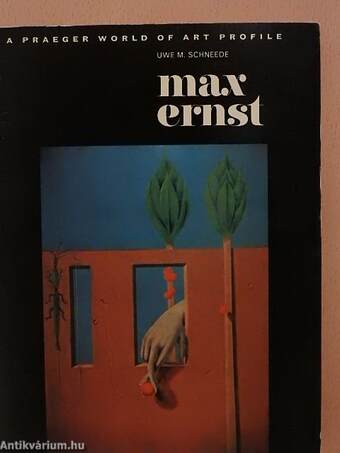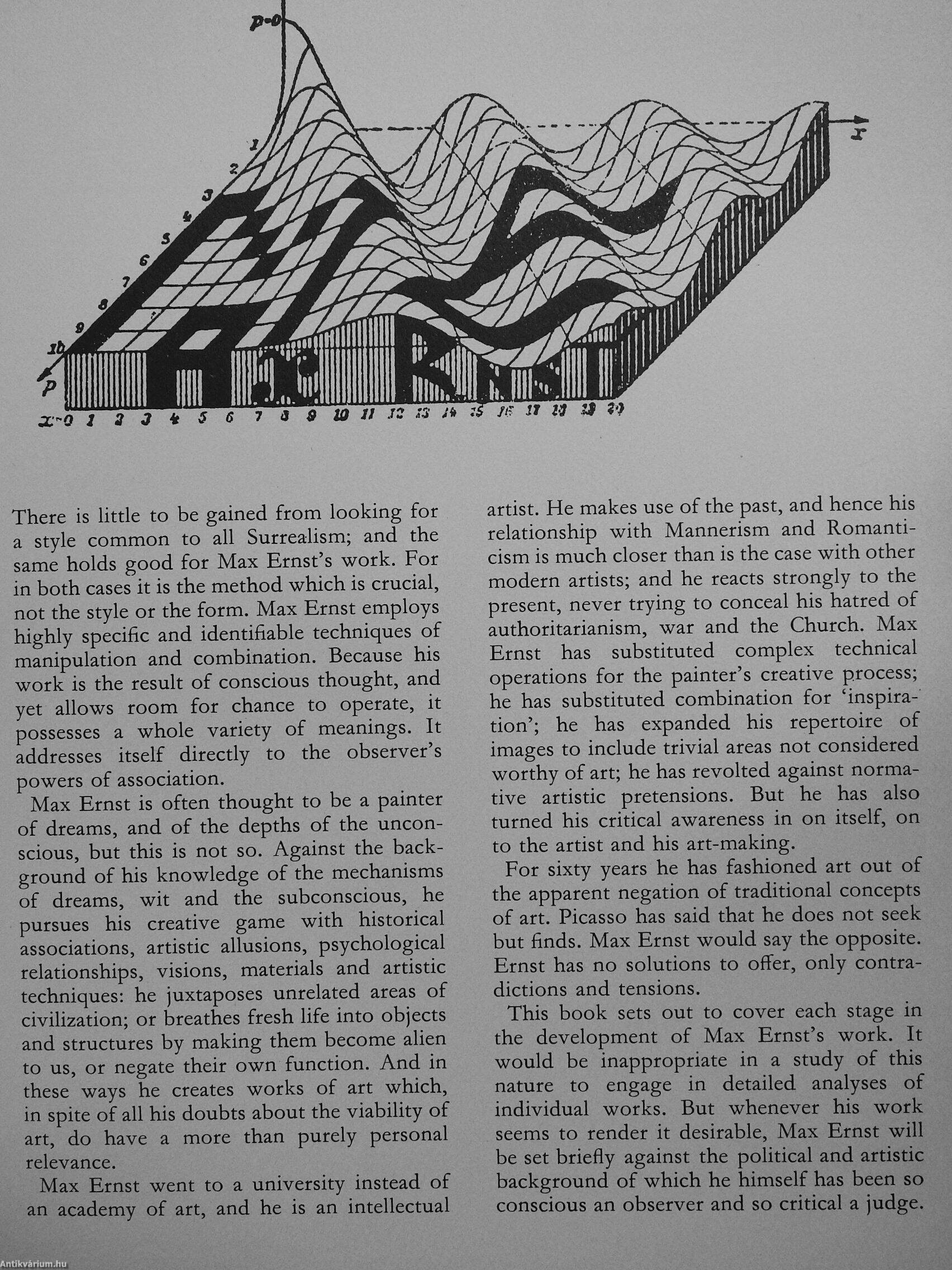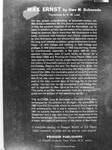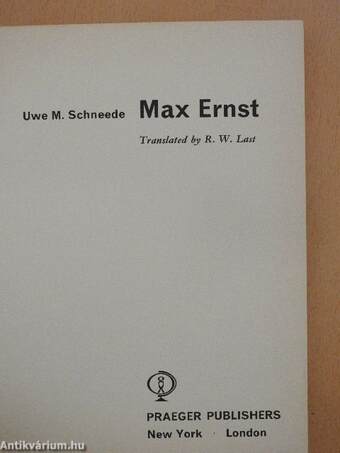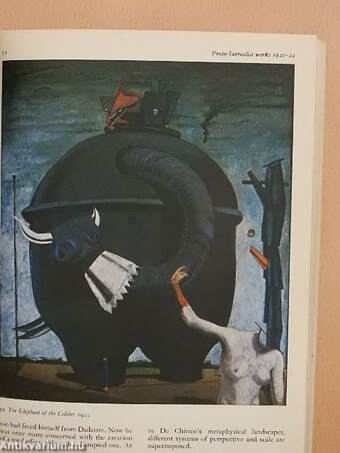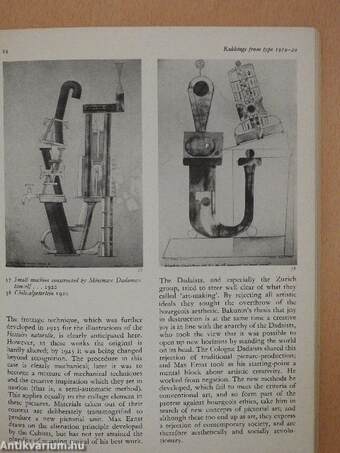1.067.062
kiadvánnyal nyújtjuk Magyarország legnagyobb antikvár könyv-kínálatát

VISSZA
A TETEJÉRE
JAVASLATOKÉszre-
vételek
Max Ernst
| Kiadó: | Praeger Publishers |
|---|---|
| Kiadás helye: | New York-London |
| Kiadás éve: | |
| Kötés típusa: | Varrott papírkötés |
| Oldalszám: | 216 oldal |
| Sorozatcím: | A Praeger World of Art Profile |
| Kötetszám: | |
| Nyelv: | Angol |
| Méret: | 21 cm x 16 cm |
| ISBN: | |
| Megjegyzés: | Színes és fekete-fehér reprodukciókat tartalmaz. |
naponta értesítjük a beérkező friss
kiadványokról
naponta értesítjük a beérkező friss
kiadványokról
Előszó
TovábbFülszöveg
For any proper understanding of 'twentieth-century art, Max Ernst is essential. No one picture or series of pictures of this, the greatest magician of all the Surrealists, can be taken In Isolation as fully representative of the multiplicity of ideas he explored. But in more than 400 illustrations in this book, combined with historical and critical commentaries % ¦ , by Uwe Schneede, we can unravel the djstinctive marks of
his long and complex evolution: great innovations in tech-nlque - in 1919 collage and rubbing, in 1925 frottage and grattage, in 1940 dëcalcomania, in 1942 drip painting; thematic inventiveness, especially in the years 1925-40; intro-• spectlve interludes, seen in such works as Design för a Manifeste) (1920) and Pain tin gs for Young People (1940); and Is astonishing climactic points, single masterpieces central to
the hlstory of twentieth-century art, such as The Elephantof the Celebes, Oed/pusRex arid The Robing of the Bride. His work evokes, with uocanny... Tovább
Fülszöveg
For any proper understanding of 'twentieth-century art, Max Ernst is essential. No one picture or series of pictures of this, the greatest magician of all the Surrealists, can be taken In Isolation as fully representative of the multiplicity of ideas he explored. But in more than 400 illustrations in this book, combined with historical and critical commentaries % ¦ , by Uwe Schneede, we can unravel the djstinctive marks of
his long and complex evolution: great innovations in tech-nlque - in 1919 collage and rubbing, in 1925 frottage and grattage, in 1940 dëcalcomania, in 1942 drip painting; thematic inventiveness, especially in the years 1925-40; intro-• spectlve interludes, seen in such works as Design för a Manifeste) (1920) and Pain tin gs for Young People (1940); and Is astonishing climactic points, single masterpieces central to
the hlstory of twentieth-century art, such as The Elephantof the Celebes, Oed/pusRex arid The Robing of the Bride. His work evokes, with uocanny accuracy, thé hideous piemoni-tions of the 1930s, the inexorable power of sexialTt^and the ~ . secret llfe (reflected in the human mind) of inanimate nature. Max Ernst, has never been at rest? toevér qii^te .precltetable, . '
even in the later, sunnler days of his lonaJlfeHn |ijs own words, "the fact that he h&$ succeeded inis<jtiitidi^.him.-self Is regarded by Max Efiiséa«*
The works of art that have resulted from this st rangeino n" , quest are the subject of this absórbing survey.
THE AUTrfÖR:
Jwe M. Schneede is Directör oTthe4/Vur- 1 ^ ={ temberglscher KunstverelnJn Stuttgart. He graduät'e'd in ' / V. 1965 from Kiel jÜnlversity where he studied Dutch painting and subsequerftly did a year's research ih the Hague. In 1967 he becarrie Assistant in the Städtische Kunsthalle in Düsseldorf and a year later took over the leadership of the WurttembergisqfterKlanstvereln, There irr 1970 he organized a major retrospéCtlve exhibitlon of the works of Max Emst.
A complete eatalog of Praeger World of Art Paperbacks currently in pri^it will be sent at your request
PRAEGER PUBLISHERS iii Fourth Avenue, New York, N.Y. 10003
Prmted m Great lir-tain Vissza
Témakörök
- Idegennyelv > Idegennyelvű könyvek > Angol > Művészetek > Festészet
- Idegennyelv > Idegennyelvű könyvek > Angol > Művészetek > Művészettörténet, általános
- Művészetek > Művészettörténet általános > Kontinensek művészete > Európa
- Művészetek > Művészettörténet általános > Idegen nyelv > Angol
- Művészetek > Festészet > Korszakok, stílusok > XX. század > Avantgárd > Szürrealizmus
- Művészetek > Festészet > Idegen nyelv > Angol
- Művészetek > Festészet > Tanulmányok, összefoglalók > Külföldi
- Művészetek > Festészet > Albumok > Külföldi festők
- Művészetek > Festészet > Általános festészet > Története



